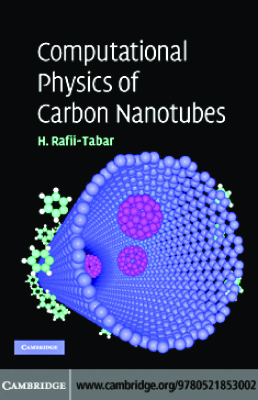Cambridge University Press, Cambridge, New York, 2007, 507 pp. -
ISBN-13 978-0-521-85300-2
The appearance of powerful high-performance computational facilities has led to the emergence of a new approach to fundamental research, namely computational modelling and computer-based numerical simulations, with applications in practically all areas of basic and applied sciences.
Carbon nanotubes are the fabric of nanotechnology. Investigation into their properties has become one of the most active fields of mode research. This book presents the key computational modeling and numerical simulation tools to investigate carbon nanotube characteristics. In particular, methods applied to geometry and bonding, mechanical, thermal, transport and storage properties are addressed. The first half describes classic statistical and quantum mechanical simulation techniques, (including molecular dynamics, monte carlo simulations and ah initio molecular dynamics), atomistic theory and continuum based methods. The second half discusses the application of these numerical simulation tools to emerging fields such as nanofluidics and nanomechanics. With selected experimental results to help clarify theoretical concepts, this is a self-contained book that will be of interest to researchers in a broad range of disciplines, including nanotechnology, engineering, materials science and physics.
Contents
Preface
Introduction
Formation of carbon allotropes
Nanoscale numerical simulation techniques
Interatomic potentials and force-fields in the computational physics of carbon nanotubes
Continuum elasticity theories for modelling the mechanical properties of nanotubes
Atomistic theories of mechanical properties
Theories for modelling thermal transport in nanotubes
Modelling fluid flow in nanotubes
Modelling gas adsorption in carbon nanotubes
Modelling the mechanical properties of carbon nanotubes
Modelling the thermal properties of carbon nanotubes
References
Index
The appearance of powerful high-performance computational facilities has led to the emergence of a new approach to fundamental research, namely computational modelling and computer-based numerical simulations, with applications in practically all areas of basic and applied sciences.
Carbon nanotubes are the fabric of nanotechnology. Investigation into their properties has become one of the most active fields of mode research. This book presents the key computational modeling and numerical simulation tools to investigate carbon nanotube characteristics. In particular, methods applied to geometry and bonding, mechanical, thermal, transport and storage properties are addressed. The first half describes classic statistical and quantum mechanical simulation techniques, (including molecular dynamics, monte carlo simulations and ah initio molecular dynamics), atomistic theory and continuum based methods. The second half discusses the application of these numerical simulation tools to emerging fields such as nanofluidics and nanomechanics. With selected experimental results to help clarify theoretical concepts, this is a self-contained book that will be of interest to researchers in a broad range of disciplines, including nanotechnology, engineering, materials science and physics.
Contents
Preface
Introduction
Formation of carbon allotropes
Nanoscale numerical simulation techniques
Interatomic potentials and force-fields in the computational physics of carbon nanotubes
Continuum elasticity theories for modelling the mechanical properties of nanotubes
Atomistic theories of mechanical properties
Theories for modelling thermal transport in nanotubes
Modelling fluid flow in nanotubes
Modelling gas adsorption in carbon nanotubes
Modelling the mechanical properties of carbon nanotubes
Modelling the thermal properties of carbon nanotubes
References
Index

